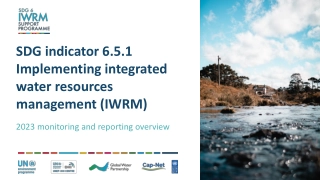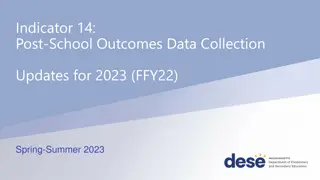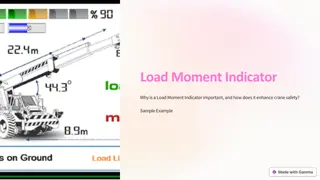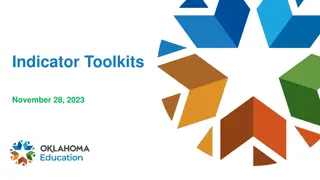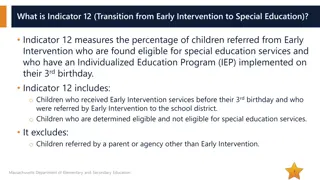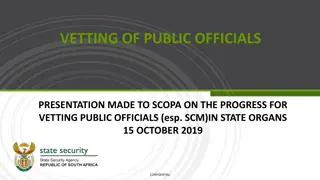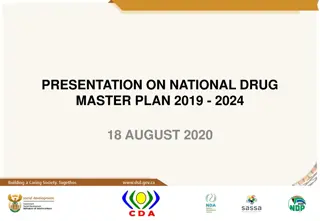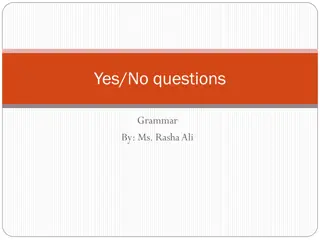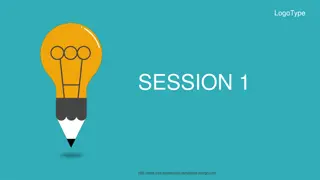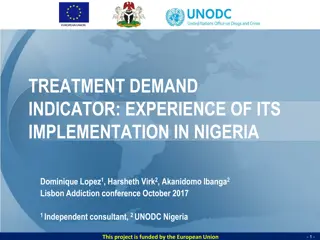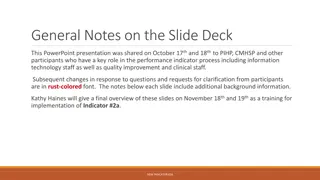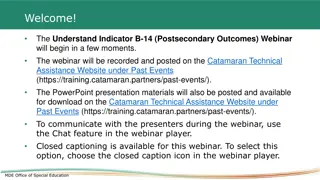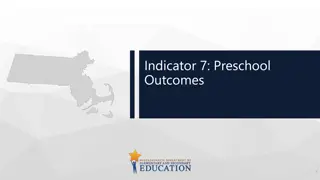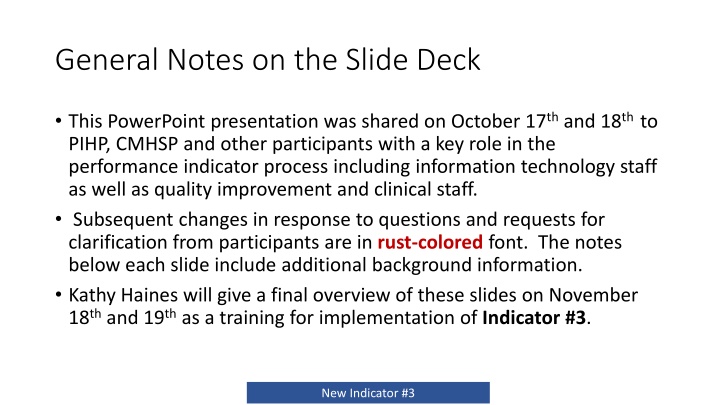
Performance Indicators in Mental Health Services
Gain insights into the new indicators introduced in the performance indicator process for mental health services. Learn about the criteria, populations, and processes involved in tracking service initiation timelines for different sub-populations.
Download Presentation

Please find below an Image/Link to download the presentation.
The content on the website is provided AS IS for your information and personal use only. It may not be sold, licensed, or shared on other websites without obtaining consent from the author. If you encounter any issues during the download, it is possible that the publisher has removed the file from their server.
You are allowed to download the files provided on this website for personal or commercial use, subject to the condition that they are used lawfully. All files are the property of their respective owners.
The content on the website is provided AS IS for your information and personal use only. It may not be sold, licensed, or shared on other websites without obtaining consent from the author.
E N D
Presentation Transcript
General Notes on the Slide Deck This PowerPoint presentation was shared on October 17thand 18th to PIHP, CMHSP and other participants with a key role in the performance indicator process including information technology staff as well as quality improvement and clinical staff. Subsequent changes in response to questions and requests for clarification from participants are in rust-colored font. The notes below each slide include additional background information. Kathy Haines will give a final overview of these slides on November 18thand 19thas a training for implementation of Indicator #3. New Indicator #2A New Indicator #3
Indicator #new 3 Percentage of new persons during the quarter starting any needed on-going service within 14 days of completing a non- emergent biopsychosocial assessment (by foursub-populations: MI-adults, MI-children, IDD-adults, and IDD-children). No Standard for 1st year of implementation will use information to determine baseline. New Indicator #3
1. 2. 3. 4. # of New Persons Who Completed a Biopsychosocial Assessment within the Quarter and Are Determined Eligible for Ongoing Services. # of Persons from Col 2 Who Started a Face-to-Face Planned Service Within 14 Calendar Days of the Completion of the Biopsychosocial Assessment % of Persons Who Started Service within 14 days of Biopsychosocial Assessment Population 1. MI-C 2. MI-A 3. IDD -C 4. IDD-A 5. Total Population New Indicator #3
Column 1 Populations Children Children are counted as such who are less than age 18 on the last day of the reporting period. Medicaid Count as Medicaid eligible any person who qualified as a Medicaid beneficiary during at least one month of the reporting period. This includes both traditional Medicaid and Healthy Michigan. Indicators # 1, 2, 3, 4, 10, and 11 are to be reported by the CMHSPs for all people served, and by the PIHPs for all their Medicaid beneficiaries. The PIHP reports these indicators for all the Medicaid beneficiaries in their region. This definition includes people who have both Medicaid and Medicare coverage. Populations not included People covered under OBRA are excluded from the indicator. People covered under the Medicaid autism benefit are currently excluded from the indicator. These Definitions are in the Performance Indicator Codebook. New Indicator #3 New Indicator #3
Column 1 Populations (cont) Intellectual Disability and Developmental Disability as defined in the Mental Health Code Mental Illness - the individual has an MI DSM Diagnosis New Indicator #3
Process for assigning people to either MI or IDD category Individuals who have both mental illness and an intellectual or developmental disability 1. If a biopsychosocial is completed for the person: Assign person to either MI or IDD category based on primary diagnosis. If person has both MI and IDD diagnoses: Assign a person as either MI or IDD based on the primary diagnosis related to the greatest level of impairment AND the services they are being referred to or being treated for. If can t determine whether MI or IDD category is predominant, categorize the person as IDD. . 2. If BPS has not (not yet) been completed for the person: Assign person to either the MI or IDD category based on the services the person requests. If the person requests both MH and IDD services, categorize the person as IDD. If it can t be determined what type of services are being requested, categorize the person as MI. REMINDER TO CLINICIANS If individual s category is different at conclusion of biopsychosocial assessment from what was entered by access screener, update the EHR accordingly so proper category is used for the indicator. NEW INDICATOR #2A New Indicator #3
Column 2 Selection Methodology Cases selected for inclusion in Column 2 are those Medicaid persons who have been reported in Column 2 of indicator #2a either during the current quarter or during the previous quarter and for whom a biopsychosocial assessment was completed during the current quarter. The person was determined eligible for mental health or intellectual and developmental disability services. Terms to Define Reportable person Eligible for MH or IDD services & supports Reporting quarter Completion of biopsychosocial Medicaid persons New Indicator #3
Column 2 Selection Methodology (cont) Reportable Person: Those who were referred for a biopsychosocial assessment Reported in Column 2 of indicator #2A Either during previous quarter or current quarter May have been Medicaid or non-Medicaid at the time. and Confirmed through the biopsychosocial assessment that the person is eligible for mental health or intellectual and developmental disability services. Important to note Those few people who are referred for a BPS and found not eligible will be reported in Indicator #2A but not in Indicator #3. New Indicator #3
Column 2 Selection Methodology (cont) The reporting period The quarter during which the biopsychosocial assessment is completed. Medicaid persons Person who qualifies as a Medicaid beneficiary during at least one month of the reporting period. If at the time the PIHP submits the indicators it is determined that the person was retroactively eligible for Medicaid during the reporting quarter then the person should be included in the Medicaid version of the indicator. Important to note A person can be non-Medicaid for indicator #2A but become Medicaid for indicator #3, or the reverse. New Indicator #3
Column 2 Selection Methodology Completion of biopsychosocial assessment Professional has submitted an encounter for the assessment. A qualified professional has determined a qualifying diagnosis for the individual. If the biopsychosocial assessment and the determination of the diagnosis occur on different dates, when both have been completed, use the latter date when calculating the time from the completion of the biopsychosocial assessment to start of on-going service. New Indicator #3
Column 2 Selection Methodology (cont) Crisis event prevents start of on-going services Person has crisis following the BPS assessment and Not able to receive a non-emergent face-to-face service within the 14-day window. Count in column #2 but not in column #3. Important to note This is just an example. This basic rule applies to any event that prevents the person from starting a scheduled on-going services. New Indicator #3
Column 3 Numerator Methodology Cases selected for inclusion in Column 3 are those in Column 2 for which a planned service was received within 14 calendar days of the completion of the biopsychosocial assessment. Terms to Define Start of on-going services Counting forward New Indicator #3
Column 3 Numerator Methodology Ongoing Services 1. Non-Emergent Does not include crisis contacts, pre-admission inpatient screening or inpatient care. And 2. Face-to-face And Defined for this indicator as any encounterable service. Included in person s plan of service Or Or Moves the person toward development of their IPOS. 3. New Indicator #3
Column 3 Numerator Methodology Counting forward Count from the date of the completed BPS assessment with the qualifying diagnosis to the date of the first service. If the first service does not start within 14 days from the completion of the BPS, then the person is not counted in the numerator (column #3). The information for the indicator is reported for the quarter during which the biopsychosocial assessment was completed. New Indicator #3
The information for the indicator is reported for the quarter during which the biopsychosocial was completed Start of On- going Services 7-9-2020 BPS 14 Days assessment 6-25-2020 7-1-2020: Start of 4th Quarter Denominator 3rd quarter Numerator 3rd quarter 1 1 New Indicator #3
Mental Health Code 330.1100 (29) "Emergency situation" means a situation in which an individual is experiencing a serious mental illness or a developmental disability, or a minor is experiencing a serious emotional disturbance, and 1 of the following applies: (a) The individual can reasonably be expected within the near future to physically injure himself, herself, or another individual, either intentionally or unintentionally. (b) The individual is unable to provide himself or herself food, clothing, or shelter or to attend to basic physical activities such as eating, toileting, bathing, grooming, dressing, or ambulating, and this inability may lead in the near future to harm to the individual or to another individual. (c) The individual has mental illness that has impaired his or her judgment so that the individual is unable to understand his or her need for treatment and presents a risk of harm. (18) "Urgent situation" means a situation in which an individual is determined to be at risk of experiencing an emergency situation in the near future if he or she does not receive care, treatment, or support services New Indicator #2A New Indicator #3
Mental Health Code 330.1100 (12) "Intellectual disability" means a condition manifesting before the age of 18 years that is characterized by significantly subaverage intellectual functioning and related limitations in 2 or more adaptive skills and that is diagnosed based on the following assumptions: (a) Valid assessment considers cultural and linguistic diversity, as well as differences in communication and behavioral factors. (b) The existence of limitation in adaptive skills occurs within the context of community environments typical of the individual's age peers and is indexed to the individual's particular needs for support. (c) Specific adaptive skill limitations often coexist with strengths in other adaptive skills or other personal capabilities. (d) With appropriate supports over a sustained period, the life functioning of the individual with an intellectual disability will generally improve. New Indicator #2A New Indicator #3
(25) "Developmental disability" means either of the following: (a) If applied to an individual older than 5 years of age, a severe, chronic condition that meets all of the following requirements: (i) Is attributable to a mental or physical impairment or a combination of mental and physical impairments. (ii) Is manifested before the individual is 22 years old. (iii) Is likely to continue indefinitely. (iv) Results in substantial functional limitations in 3 or more of the following areas of major life activity: (A) Self-care. (B) Receptive and expressive language. (C) Learning. (D) Mobility. (E) Self-direction. (F) Capacity for independent living. (G) Economic self-sufficiency. (v) Reflects the individual's need for a combination and sequence of special, interdisciplinary, or generic care, treatment, or other services that are of lifelong or extended duration and are individually planned and coordinated. (b) If applied to a minor from birth to 5 years of age, a substantial developmental delay or a specific congenital or acquired condition with a high probability of resulting in developmental disability as defined in subdivision (a) if services are not provided. New Indicator #2A New Indicator #3
(2) "Serious emotional disturbance" means a diagnosable mental, behavioral, or emotional disorder affecting a minor that exists or has existed during the past year for a period of time sufficient to meet diagnostic criteria specified in the most recent Diagnostic and Statistical Manual of Mental Disorders published by the American Psychiatric Association and approved by the department and that has resulted in functional impairment that substantially interferes with or limits the minor's role or functioning in family, school, or community activities. The following disorders are included only if they occur in conjunction with another diagnosable serious emotional disturbance: (a) A substance use disorder. (b) A developmental disorder. (c) "V" codes in the Diagnostic and Statistical Manual of Mental Disorders. New Indicator #2A New Indicator #3
(3) "Serious mental illness" means a diagnosable mental, behavioral, or emotional disorder affecting an adult that exists or has existed within the past year for a period of time sufficient to meet diagnostic criteria specified in the most recent Diagnostic and Statistical Manual of Mental Disorders published by the American Psychiatric Association and approved by the department and that has resulted in functional impairment that substantially interferes with or limits 1 or more major life activities. Serious mental illness includes dementia with delusions, dementia with depressed mood, and dementia with behavioral disturbance but does not include any other dementia unless the dementia occurs in conjunction with another diagnosable serious mental illness. The following disorders also are included only if they occur in conjunction with another diagnosable serious mental illness: (a) A substance use disorder. (b) A developmental disorder. (c) A "V" code in the Diagnostic and Statistical Manual of Mental Disorders. New Indicator #2A New Indicator #3

